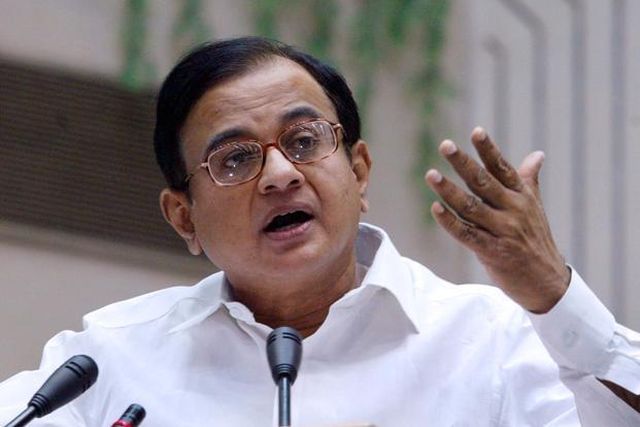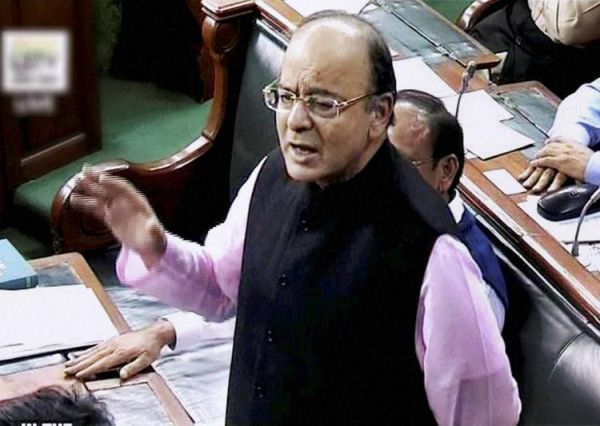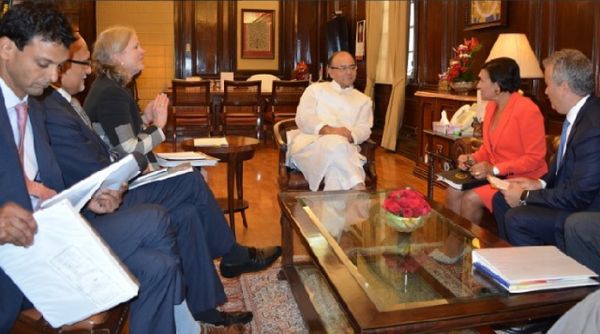
by admin | May 25, 2021 | Economy, News, Politics
 New Delhi : Senior Congress leader and former Union Finance Minister P. Chidambaram said on Saturday that the Indian economy was going down and that the growth rate during the present NDA rule was lower than during the earlier UPA’s time.
New Delhi : Senior Congress leader and former Union Finance Minister P. Chidambaram said on Saturday that the Indian economy was going down and that the growth rate during the present NDA rule was lower than during the earlier UPA’s time.
In a series of tweets, he said while India’s growth rate during the first two quarters of this financial year was lower than the 30-year average, the average growth rate in four years of National Democratic Alliance rule was also lower than previous United Progressive Alliance’s 10-year average.
“Former World Bank Chief Economist Dr Kaushik Basu said India’s growth rate was lower than the 30-year average. (The) Finance Minister says that the growth rate is better,” the Congress leader tweeted.
Basu had in an interview to The Hindu newspaper said that India’s annual growth was 6.6 per cent over the last 30 years while during the first two quarters of this financial year, annual growth was 5.7 per cent and 6 per cent respectively.
Chidambaram added: “What is the average of four years of NDA? It is 7.3 (per cent) under new methodology and lower than UPA’s 10-year average.”
“What is the direction of NDA’s growth rate? Investments? Savings? Credit growth? All downward.”
Finance Minister Arun Jaitley in his Budget speech had said that the Indian economy had performed really well since the BJP-led government took over in May 2014.
—IANS

by admin | May 25, 2021 | Corporate, Corporate finance, Corporate Governance, Economy, News, Politics
 By Porisma P. Gogoi,
By Porisma P. Gogoi,
New Delhi : The government’s move to increase expenditure on food processing, infrastructure, healthcare and rural economy will generate more demand for the fast moving consumer goods (FMCG) sector, said industry players.
“The country has been through two muted years of growth after economic reforms like demonetisation and GST (Goods and Services Tax). Hence, from the Union Budget 2018-19, expectation was to see policies and steps to boost growth,” Harsha V. Agarwal, Director, Emami, told IANS.
“Infrastructure, education, healthcare and rural economy are the major beneficiaries from this budget, signalling more job creation and spending power in the hands of the largest population which will automatically help the FMCG sector by generating strong demand,” Agarwal said.
The various measures announced by the government will lead to increase in rural consumption, improve overall rural economy and have a trickling effect on the corporates, according to Sanjana Desai, Head of Business Development, Desai Brothers (Food Division – Mother’s Recipe).
Desai Brothers owns and manages the brand Mother’s Recipe — a food company which makes a vast range of pickles, pastes and ready-to-cook mixes.
“The Union Budget 2018-19 is largely positive for FMCG. As anticipated by the FMCG sector, government’s thrust on boosting the rural economy is welcome,” said Desai.
“Increased allocation under various schemes such as MNERGA (Mahatma Gandhi National Rural Employment Gurantee Act), rural infrastructure and others will not only increase rural income through employment generation by these projects but will also improve connectivity giving a boost to rural/agri businesses,” she added.
In the last full budget just presented by Finance Minster Arun Jaitley before the 2019 general elections, the government announced that it would spend more on agriculture, livelihood and infrastructure in the rural area and increased funds for crop insurance, rural roads, irrigation besides setting higher targets for farm credit.
With total budgetary outlay of Rs 2,01,933 crore for agriculture and rural development, the government has emphasised on development of food processing, dairy and fishery sectors to enhance farmers’ income.
The industry players also appreciated the Finance Minister’s move to reduce the corporate tax rate for all companies with turnover of up to Rs 250 crore, up from Rs 50 crore.
“We welcome government’s move to reduce corporate tax from 30 per cent to 25 per cent for companies with revenue of up to Rs 250 crore. This initiative will give a boost to company revenue and allow businesses like us to invest more in expansion leading to employment generation, which is a primary focus for the government,” said Oliver Mirza, Managing Director and CEO, Dr Oetker India.
Dr Oetker India is a German packaged food company which acquired the Fun Foods brand in 2008.
“This move will also provide a great stimulus to the government’s initiatives like ‘Make in India’ and ‘Startup India’. Tax benefits combined with increased allocation to the food processing sector will give a great impetus to the overall FMCG industry,” Mirza said.
(Porisma P. Gogoi can be contacted at porisma.g@ians.in)
—IANS

by admin | May 25, 2021 | News, Politics
 Shillong : Meghalaya Chief Minister Mukul Sangma on Thursday thanked Prime Minister Narendra Modi for replicating the Megha Health Insurance Scheme, one of the flagship programme launched by the state’s Congress government, on the national level.
Shillong : Meghalaya Chief Minister Mukul Sangma on Thursday thanked Prime Minister Narendra Modi for replicating the Megha Health Insurance Scheme, one of the flagship programme launched by the state’s Congress government, on the national level.
In his Budget 2018-19 speech on Thursday, Finance Minister Arun Jaitley announced a flagship National Health Protection Scheme under which Rs 5 lakh cover will be provided per year to 10 crore poor and vulnerable families in the country.
“The Central government in fact invited the State government to present this exemplary health initiative to other states. I must thank him (Prime Minister) for replicating the scheme,” Sangma told IANS over phone.
Noting that Megha Health Insurance Scheme is one of the transformations in the state’s health sector, he said: “There is no programme as inclusive as ours. Our scheme did not confined only to BPL (Below Poverty Line) families, but we extended it to everybody….”
“Not just this health scheme, we have one of the best Intensive Care Units in government Ganesh Das hospital and Tura hospital. We have made it slow but steady progress in health care sector. And the most important is that we have been able to take care of the expenditure for the medical treatment,” he added.
On Modi’s allegation about the state’s “poor” health sector, Sangma said that “it was unfortunate for the Prime Minister… obviously because he did not do his homework properly”.
The Chief Minister also exuded confidence that his party will retain power in Meghalaya, while saying the results of the Rajasthan bypolls where the party wrested two parliamentary and one assembly seat from the ruling BJP an indication “people’s actual anger and frustration” against the BJP and a sign that Congress will return to power in the 2019 general elections.
—IANS

by admin | May 25, 2021 | Investing, Opinions, Property
 By Sudhir Pai,
By Sudhir Pai,
Much on expected lines, the government in Budget 2018-19 has continued with its thrust for Affordable Housing and Housing for All scheme. The government has been consistent with its efforts in addressing affordable housing in 2017 — be it giving infrastructure status to this segment in the previous budget, to helping increase the quantum of beneficiaries in CLSS under Pradhan Mantri Awas Yojana (PMAY) by expanding the carpet area and re-defining income definitions. Now, Budget 2018-19 has further given impetus to affordable housing by creating a dedicated fund under the National Housing Bank (NHB).
This fund will be provided for from priority sector lending and fully serviced bonds authorised by the Government of India. Now that the government has created significant enablers to increase demand and to create favourable conditions, we should hopefully see a significant spike in new launches/supply in the coming days in the affordable housing segment.
It is also encouraging to see the government address the issues of housing in urban areas. While providing assistance to construct 37 lakh houses in urban areas will take care of the urban housing woes, financial assistance (Rs.2.04 lakh crore) to 99 Smart Cities will ease the pressure on the existing urban centres.
Further, the Finance Minister also proposed that no adjustment shall be made in respect of transactions in immovable property, where the circle rate value does not exceed 5 per cent of the consideration — this would affect only those localities where circle rates are higher than prevailing market rates. The government steered clear of further tax breaks for either industry or for the buyers.
That said, the government has been actively regulating the real estate industry over the last several quarters. From demonetisation aimed at curbing the effect of unaccounted money; to RERA which will help bring in consumer confidence, the real estate sector has seen significant regulatory influence in the past year.
While the budget is now done and dusted, there are some matters which would help drive the industry ahead more vigorously. We hope that going ahead the government will (a) address the issue of GST on new homes which is currently inflationary (b) examine the issue of lowering the cost of transactions, particularly stamp duty and registration fees (c) create enablers for the sector such as digitisation of property registries; guaranteeing or insuring land/property titles; enhancing liquidity in real estate markets through REITs and other means and (d) strengthen RERA to resolve disputes speedily and help drive confidence amongst consumers.
As we’ve been saying for a while now, there are green shoots emerging in the industry once again and we expect a gradual recovery in the course of 2018. With the government having done its bit, there is now need for concerted and purposeful action from developers and other stakeholders in the industry to do their bits and help the process for a better 2018 for real estate.
(Sudhir Pai is CEO of magicbricks. He can be contacted at sudhir.pai@timesgroup.com)
—IANS

by admin | May 25, 2021 | Opinions
 By Amit Kapoor and Chirag Yadav,
By Amit Kapoor and Chirag Yadav,
The Budget is finally out and to put it simply, Mr. Jaitley did not disappoint. In fact, a majority of it was along expected lines. Most importantly, as promised, the government managed to do a commendable job of balancing economic populism with prudent economics. However, as is always the case, the good did come with a tinge of bad.
It was a no-brainer that the Budget would focus on the agricultural sector after BJP’s electoral performance in rural Gujarat. Mr. Jaitley went a step further and, in a major departure from the past, began his Budget speech with the government’s plan for the farming community. He unveiled a litany of measures in line with the government’s aim of doubling farmer incomes by 2022.
First, the Budget allowed for setting the minimum support price (MSP) at 1.5 times the production cost for kharif crops. Even though this support to farmers will help increase their incomes, there are two questions that need to be asked. Will the effect of this jump in MSP be inflationary? Also, will it take away the incentive to reduce production costs? The answer to both of these questions is probably in the affirmative. Only time will tell if the move has any such negative externalities for the economy, but the government should be prepared with commensurate remedies to tackle the eventuality.
The second significant move on the agricultural front has been a push to boost agri-business activities across the country and improve agricultural markets. Allocation has been doubled for enhancing food processing and specialised agro-processing networks from Rs 700 crores to Rs 1,400 crores. The government has also decided to follow a cluster-based approach for stimulating agricultural production. Further, in a bid to formalise agricultural markets, the 470 Agriculture Produce Market Committee (APMC) promoted markets would be connected to the e-nam market platform and over 22,000 rural agricultural markets would also be developed. These are positive moves to remove the middle man and ensure farmers receive the bulk of the prices paid by the consumer.
However, the e-nam platform is still in its formative stage and its performance has not been adequately tested. A bulk of the sale of agricultural products is still done through commission agents and it is doubtful that the practice will be done away with any time soon. On the other hand, the development of agri-business clusters provides a viable solution to formaliseagricultural markets. The gains from all of these measures, however, can only be expected in the long-run.
Another major highlight of the budget has been its focus on the social sector. Healthcare and education received their fair share of budgetary focus. In fact, Mr. Jaitley took pride in announcing the “world’s largest healthcare programme” that would provide Rs 5 lakhs per family per year for medical reimbursement under National Health Protection Scheme for around 10 crore families across India. This is a positive move by the government towards universal health coverage in the future. As for education, digitalisation of education and training of teachers was given a boost. In monetary terms, the increase in budgetary allocation from last year is about 3.84 percent and that for healthcare is about 2.76 percent. This seems like a significant boost in absolute terms, but it pales in comparison when seen in light of the overall GDP growth of 6.75 percent. Considering the fact that India lags on these social parameters, this historical trend in Indian budgets need to come to an end.
As for taxes, the corporate sector, which was expecting a tax cut on commensurate lines as that of the US economy, was partly obliged. Corporate tax for all companies with a turnover of Rs 250 crores or less was reduced to 25 per cent. This proved to be a major disappointment to large firms whichwill still be taxed at 30 per cent. However, it was understandable on the government’s part as the revenue forgone would have been an astounding Rs 20,000 crores had the tax reduction been done for all firms alike.
On a related note, a significant miss by the Budget has been on the investment front. Over the last six years, the investment across the country has been on a declining trend falling to 29 percent as per last CSO estimates. No major announcement was made to reverse this trend expect indirect measures like higher infrastructure allocation, which might be expected to crowd in private investment. However, considering the fact that investment has seen a structural decline over the last few years a lot could have been done to revive investment sentiments. This is also important because the question of jobs is largely dependent on the economy’s investment appetite.
Finally, the much-awaited question about the fiscal deficit was answered and the government did eventually breach the target of 3.2 percent in 2017-18. The revised estimate of the fiscal deficit in the current financial year stands at 3.5 percent while the projection for next year has been kept at 3.3 percent. The NK Singh Committee had allowed a leeway of 0.5 percent in case of unforeseen events and the government has managed to stay within it. The government also accepted its recommendation to maintain the debt-to-GDP ratio at 40 percent. It is commendable that the government has not given in to the temptation of reaping short-term political gains by disregarding the recommendations of the fiscal committee.The commitment would bode well with credit rating agencies and the economy in general.
Therefore, the Budget paints a promising picture of a government that saw it fit not to resort to populist ploys even after it received an election scare not long ago. Even though a lot was left wanting, especially on the investment front, the Budget managed to address quite a few economic challenges that India faces. By targeting the rural economy and the poor, it can be said that it was a Budget for the masses.
(Amit Kapoor is chair, Institute for Competitiveness, India. The views expressed are personal. He can be contacted at amit.kapoor@competitiveness.in and tweets @kautiliya. Chirag Yadav is senior researcher, Institute for Competitiveness)
—IANS

 New Delhi : Senior Congress leader and former Union Finance Minister P. Chidambaram said on Saturday that the Indian economy was going down and that the growth rate during the present NDA rule was lower than during the earlier UPA’s time.
New Delhi : Senior Congress leader and former Union Finance Minister P. Chidambaram said on Saturday that the Indian economy was going down and that the growth rate during the present NDA rule was lower than during the earlier UPA’s time.



